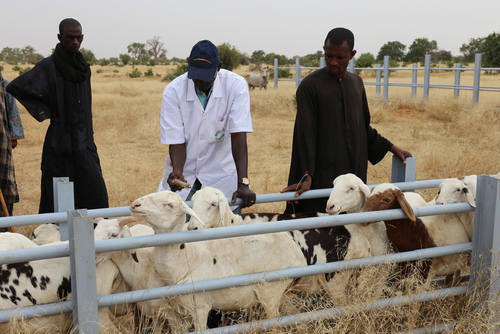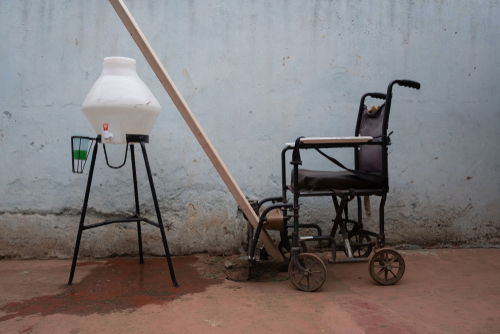February 19, 2024

Antimicrobial resistance hotspots in food animals in low- and middle-income countries
OHT researcher Dr. Thomas Van Boeckel co-authored a study that identified China, India, Brazil, Chile, central Asia, and southeastern Africa as hotspots of antimicrobial resistance (AMR) in food animals. Tetracycline had the highest average resistance prevalence in Escherichia coli (59 percent) and non-typhoidal Salmonella species (54 percent). Projections suggest that resistance to tetracycline and ampicillin could exceed critical levels in Africa and South America, while resistance to ampicillin and sulphonamides could exceed these levels in Asia. [Nature Communications]
Maternal bacterial colonization in Bangladesh increased after childbirth.
A cohort study reveals high rates of colonization with extended-spectrum beta-lactamase–producing bacteria (ESBL-PB) and carbapenem-resistant bacteria (CRB) among mothers and newborns in a hospital in Faridpur, Bangladesh. After delivery, 98 percent of mothers were colonized with ESBL-PB and 89 percent with CRB, compared to 77 and 15 percent before delivery, respectively. Post-delivery maternal colonization was correlated with cesarean sections, high antibiotic use, and poor infection prevention control measures. [Antimicrobial Resistance & Infection Control]
Challenges and misconceptions about zoonotic malaria in Southeast Asia and the Western Pacific
A systematic review revealed knowledge gaps and barriers to zoonotic malaria prevention in the WHO Southeast Asia and Western Pacific Regions. While participants had a good understanding of malaria causation and transmission, some studies highlighted misconceptions about malaria among minority and indigenous ethnic communities, including the belief that malaria can be contracted by drinking dirty water. Challenges to malaria prevention in these regions included the feasibility of mosquito control products, cultural beliefs about malaria, and limited access to healthcare services. [BMC Public Health]
Gaps in the literature on wildfire smoke risk communications
A scoping literature review revealed gaps in research on wildfire smoke risk communications for public audiences. Notably, studies on wildfire smoke risk communications created with and for vulnerable populations, such as communities with low Internet connectivity and rural communities, are largely absent from publication databases. Furthermore, no articles assessed the role of health literacy in wildfire smoke risk communications, exposing a major gap in the current body of literature on wildfire smoke exposure. [BMC Public Health]
Adapting nutrition-based interventions to address malnutrition
A systematic review revealed a potential for adapting current nutrition interventions to mitigate overnutrition and undernutrition (also known as the double burden of nutrition) in low- and middle-income countries. Interventions that address determinants of under and overnutrition – such as food insecurity and maternal and child health – should incorporate specific nutritional targets to enhance their effects on the double burden of nutrition. In regions undergoing rapid diet transformation, policymakers must carefully craft nutrition-based maternal and child health interventions to avoid inadvertently increasing the overweight or obesity burden. [The Lancet Global Health]
The WHO-recommended typhoid conjugate vaccine confers protection for at least four years.
While it has been shown that the typhoid conjugate vaccine (TCV) confers short–term protection, data on longer-term efficacy, particularly among children in Africa and Asia, is sparse. A randomized controlled trial in Blantyre, Malawi, where children aged 9 months to 12 years received the WHO-recommended Vi-TT TCV, showed a cumulative vaccine efficacy of 78.3 percent (95% CI: 66.3-86.1%) against blood culture-confirmed typhoid fever nearly 5 years after vaccination. While protection was found in all age groups, the lowest vaccine efficacy (70.6 percent ) was observed in the under-two age group, in line with findings from previous studies. [The Lancet]
Differences in bacterial carriage between daycare-going children in the Netherlands and Belgium
A point-prevalence study of daycare centers (DCCs) in the Netherlands and Belgium found that children attending DCCs in Belgium had a significantly higher prevalence of extended-spectrum beta-lactamase–producing Enterobacterales (16 percent versus 6 percent) and ciprofloxacin-resistant Enterobacterales (17 percent versus 8 percent) than children attending DCCs in the Netherlands. The use of antimicrobials and hospital admissions among children attending DCCs were also significantly higher in Belgium than in the Netherlands. Lower preventive hygiene measures and more time spent in daycare may increase the risk of AMR in children. Ecological cross-border studies investigating potential risk factors are needed to inform policies that address antibiotic use and hospital admissions in children. [BMC Infectious Diseases]
Geographic and disease disparities in neglected tropical disease research
A scoping review highlighted notable progress and gaps in the literature on control, elimination, and eradication efforts for neglected tropical diseases (NTDs) in the WHO African Region between 1990 and 2022. Discrepancies in the number of studies assessing NTD control efforts were observed by geographic region and disease type. Trachomas, lymphatic filariasis, and schistosomiasis were the most represented in the review, while the literature on other NTDs that threaten human and animal health in Africa was limited. Multi-NTD control efforts and standardized monitoring and evaluation of NTD programs are needed to provide more comprehensive assessments of NTD progress in the WHO Africa Region. [International Journal of Infectious Diseases]
Future directions for Vietnam’s national action plan on AMR
A scoping review characterized the health system barriers to the implementation of Vietnam’s National Action Plan for Antimicrobial Resistance (NAPCA), including limited cooperation between Ministry of Health departments, a lack of human resources, and poor alignment between national and hospital infection treatment guidelines. Key informants in Vietnam also revealed that a shortage of human resources and insufficient funding drive inappropriate antibiotic use in hospitals despite some successful antimicrobial stewardship efforts. Vietnam’s new NAPCA, currently under development, must address these systemic barriers to AMR mitigation strategies to enhance its implementation and success. [Antimicrobial Resistance & Infection Control]
Image from Shutterstock











